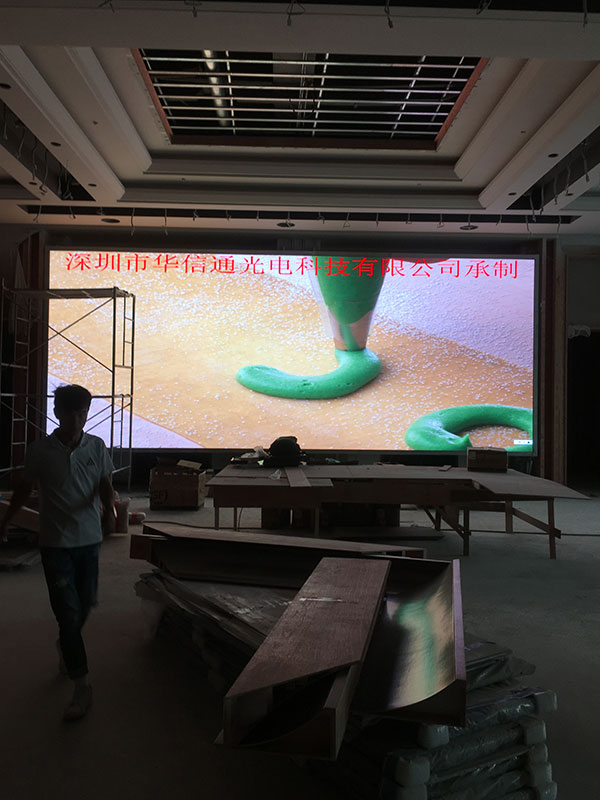Full color high-definition LED display screens can indeed bring users more high-definition and delicate images, but their application requirements vary depending on different application scenarios. Compared to conventional screens, large-scale stage performances and live streaming programs require higher uniformity of image quality for LED electronic screens. If LED electronic screens are not calibrated, better picture quality uniformity will not be achieved. Therefore, Huaxintong Optoelectronics LED display manufacturers will calibrate the screen for applications with generally high requirements.

Can LED electronic screens be left uncorrected?
The uniformity calibration of LED electronic large screens is divided into factory calibration, repair calibration, service area calibration, and on-site calibration. So why is it necessary to calibrate high-definition LED displays? It is because the LED display screen itself is packaged with thousands of light beads, and each bead automatically emits light. However, due to the different working conditions of each LED when playing videos and other images, some may remain low on or not working, while others may remain high on and work for a long time. It is precisely because these light beads work differently that their LED light-emitting tubes experience varying degrees of brightness attenuation, and the attenuation curves of the three primary colors are also different.
That is to say, when LED light-emitting tubes experience varying degrees of brightness attenuation, the brightness will also decrease, resulting in uneven pixel colors in the displayed image, which affects the overall aesthetic of the image. When the brightness of a high-definition LED display screen decays, the entire image will appear in a granular display state, or the overall brightness will decrease. This is because the different attenuation curves of the three primary color tubes cause the white balance and color temperature to quietly change, thereby affecting the overall aesthetic of the image.
Therefore, after a period of use, LED displays may experience LED tube decay, which is also related to factors such as environmental temperature. If the installed LED electronic large screen is disassembled and sent back to the LED display manufacturer for calibration, it is not very practical in terms of disassembly, logistics transportation, and reinstallation. Therefore, LED display manufacturers need to send professional technicians to the site for calibration to ensure screen brightness and color uniformity. Generally speaking, Huaxin Tong Optoelectronics will use two methods for calibration: LED operation timing calibration and on-site collaborative calibration.
Calibration of LED operation time
The so-called LED operation time calibration method is to calibrate the LED display screen on site based on the recorded operation time of each LED module. By roughly calculating the working time of each LED, measuring their uniform brightness attenuation, estimating different calibration levels, and then sending them to each LED module for corresponding adjustments. Although this method greatly reduces manual input, the estimated LED attenuation frequency is not applicable to any LED bead.
As the operating time increases, the LED attenuation frequency also increases. Calibration on a uniform basis can indeed calibrate some LED beads, but it can also damage some LED beads. After all, the degree of attenuation of each lamp bead is different. If the same standard is used for calibration, there will definitely be a situation where some lamp beads can be calibrated well while others are not calibrated properly. Because the brightness levels of each module are different, it is impossible to perform overall calibration on modules with mismatched brightness. Therefore, when calibrating different modules through runtime methods, true uniformity consistency cannot be achieved, and pixel calibration cannot be completed. Moreover, the corrected screen may exhibit mosaic and other phenomena, which seriously affect the quality and display performance of the screen.
On site collaborative proofreading
In order to achieve uniformity in the LED beads of high-definition LED display screens, specialized equipment must be used on site to quickly collect the light color information of each pixel point of the LED display screen. Relevant algorithms should be used to compensate for the actual attenuation degree of each LED light-emitting tube, thus completing collaborative calibration. Through this proofreading method, the uniformity issue of LED display screens can be largely restored, resulting in higher definition and finer images.
In summary, after a period of use, high-definition LED displays may experience varying degrees of brightness attenuation due to the different working conditions of each LED bead, frequency of use, and brightness during operation, which can affect the overall visual aesthetics. In order to provide a better viewing experience for the audience, Huaxintong Optoelectronics LED display manufacturers will send professional technicians to the site for proofreading, using a standardized on-site proofreading method to ensure consistent screen brightness and color uniformity.